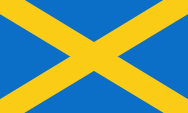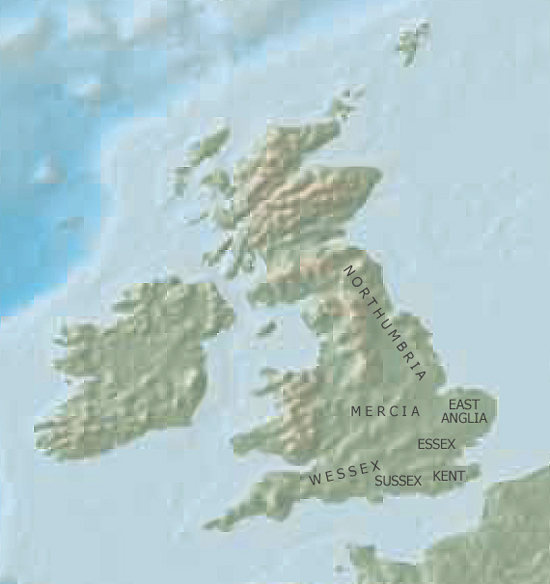mobile View, to the German Version tap the flag


- Mercia
- former Kingdom in Middle-England
- own name: Miercna rīce
• Introduction
• History
• Flag
• Meaning/Origin of the Flag
• Map
• Origin of the Country's Name
Britannia was conquered by Roman legions around the year 43 and became in 85 a province of the Roman Empire. Towards the end of the fourth century the Roman Empire came under considerable pressure from outside, so that Britannia could no longer be held. Thus the Romans began to withdraw about 400 or 410. Shortly afterwards, Jutes and Angles began to migrate in eastern and southern Britannia coming from today's Denmark and Saxons coming from the area of the Weser and Elbe estuaries, and also some Frisians. The differences between the peoples blurred over the generations, and they were summarized under the term Anglo-Saxons. As fighters they have been very welcome for the mostly Romanesque Celtic British, against the since the withdraw of the Romans advancing Picts and Scots. Already in the middle of the fifth century, they had established themselves as the new aristocracy and began to separate from themselves by the formation of their own kingdoms. Since the beginning of the 6th century, seven great kings have been known which dominated the south and east of Britannia. A formation of states that has become known in history as "Heptarchy" (Greek: hepta = seven). These have been the kingdoms of Sussex, Wessex, Essex, Kent, East Anglia, Mercia and Northumbria. However, in reality, there have been more and some smaller kingdoms, which, however, often existed for only a short time. In 825 Wessex, Sussex, Kent and Mercia became united under King Egbert of Wessex. Essex, East Anglia and parts of Mercia were occupied by invading Danes in the year 865 and became summarized as "Danelaw" (Danelag, territory of Danish law). In 1016 the Danish Knut the Great (brother of the king of Denmark) forced his election to the first king of England. After riots the Danish rule ended in 1050, and in 1066 Harald II., Earl of Wessex, was crowned to the first Anglo-Saxon King of England.
Source: Wikipedia (D)

In the 6th century, Angles from today's Denmark migrated into Middle-England. The founding of the Kingdom of Mercien is hidden in the dark of the past and is suspected in the 6th century. Icel, the founder of the Kingdom, came himself still from from Denmark. The last pagan king Penda died in 655 in a battle against the kingdom of Northumbria and Mercien came under the rule of Northumbria. However, by a coup in the year 658, Wulfhere, the youngest son of Penda, was established as king of Mercia. At the end of the 7th century, Mercia could expand ist influence over the kingdoms of Lindsey and Hwicce, which was lost again at the beginning of the 9th century. It began slow decay. King Egbert of Wessex defeated Beornwulf of Mercien in 825 in the Battle of Ellandun and Merciem had to cede large territories in the south to Wessex. FFrom the middle of the 9th century onwards, Viking tribesmen frequently invaded, who finished the independent kingship of Mercia in 874. From about 880 Mercia was administered by the Kingdom of Wessex.
Source: Wikipedia (D)


Flag of Mercia,
ratio = 3:5,
Source, by: Wikipedia (EN)






The time of the Heptarchy belongs – in the themes of flags or coats of arms – to the period of protoheraldics. This means that seals, coats of arms or flags, as we know them today, were not yet in use. Nevertheless, it seems that there was a kind of symbolism, which is partly handed down, or it is known from the field of legends. The coats of arms or flags were designed in the modern age, which are used now for the ancient kingdoms of the Heptarchy.
The heraldry of Mercia, which is known today, seems to be not authentic because no signs or symbols have been handed down. The symbolism, now known as the "Cross of St. Alban", is also known as "Saltire", shows yellow St. Andreas cross on blue. It should have been used by King Offa (757-796). As the symbol of Mercia, the cross of St. Alban was first mentioned in the 13th century. After all, it became to the coat of arms of the monastery of St. Alban, which was founded by Offa. After the dissolution of the monastery, the cross was taken over in 1634 as the coat of arms of St. Albans Town. And the flag still flown until today at Tamworth Castle, the ancient seat of the kings of Mercia, northeast of Birmingham, and it is very popular in the region.
Source: Wikipedia (EN), Volker Preuß


Source: Freeware, University of Texas Libraries, modyfied by: Volker Preuß

The name of the country, Mercia, is related to the German word for a border area: "Mark". Probably the country had seen itself as a bordering area to the Celtic-British territories in the West.
Source: Wikipedia (D)


![]()






